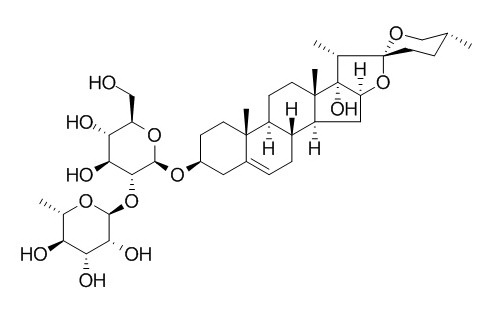Polyphyllin VI
Polyphyllin VI and polyphyllin VII possess anti-cancer activities, they exhibits strong inhibitory effects on lung cancer cell growth in vitro and in vivo by inducing G2/M cell cycle arrest and triggering apoptosis.
Inquire / Order:
manager@chemfaces.com
Technical Inquiries:
service@chemfaces.com
Tel:
+86-27-84237783
Fax:
+86-27-84254680
Address:
1 Building, No. 83, CheCheng Rd., Wuhan Economic and Technological Development Zone, Wuhan, Hubei 430056, PRC
Providing storage is as stated on the product vial and the vial is kept tightly sealed, the product can be stored for up to
24 months(2-8C).
Wherever possible, you should prepare and use solutions on the same day. However, if you need to make up stock solutions in advance, we recommend that you store the solution as aliquots in tightly sealed vials at -20C. Generally, these will be useable for up to two weeks. Before use, and prior to opening the vial we recommend that you allow your product to equilibrate to room temperature for at least 1 hour.
Need more advice on solubility, usage and handling? Please email to: service@chemfaces.com
The packaging of the product may have turned upside down during transportation, resulting in the natural compounds adhering to the neck or cap of the vial. take the vial out of its packaging and gently shake to let the compounds fall to the bottom of the vial. for liquid products, centrifuge at 200-500 RPM to gather the liquid at the bottom of the vial. try to avoid loss or contamination during handling.
Appl Biochem Biotechnol.2020, 190(2):732-744
Oxid Med Cell Longev.2021, 2021:6647107.
Planta Med.2019, 85(9-10):766-773
J. Traditional Thai Medical Res. 2022,8(1):1-14.
Pharmaceutics.2020, 12(9):845.
Int. J. Mol. Sci.2022, 23(14),7699;
BMC Plant Biol.2020, 20(1):214.
Molecules.2020, 25(23):5556.
Biochem Biophys Res Commun.2017, 494(3-4):587-593
Chemistry of Plant Raw Materials2019, 4:135-147
Related and Featured Products
Phytother Res. 2015 Oct;29(10):1568-76.
Anti-lung Cancer Effects of Polyphyllin VI and VII Potentially Correlate with Apoptosis In Vitro and In Vivo.[Pubmed:
26272214]
Polyphyllin VI (PVI) and Polyphyllin VII (PVII) derived from Paris polyphylla possess anti-cancer activities. However, the mechanisms for the anti-lung cancer effects of PVI and PVII remain poorly understood.
METHODS AND RESULTS:
In this study, PVI and PVII exhibited inhibitory effects on the proliferation of A549 and NCI-H1299 cells. PVI and PVII induced G2/M cell cycle arrest and triggered apoptosis. PVI and PVII upregulated the tumor suppressor protein p53 and downregulated cyclin B1. The two treatments significantly increased the expression levels of death receptor 3, death receptor 5, Fas, cleaved PARP, and cleaved caspase-3. Furthermore, PVI and PVII significantly inhibited the growth of A549 cells in vivo. The tumor inhibitory rates of PVI were 25.74%, 34.62%, and 40.43% at 2, 3, and 4 mg/kg, respectively, and those of PVII were 25.63%, 41.71%, and 40.41% at 1, 2, and 3 mg/kg, respectively. Finally, PVI and PVII regulated the expression of proteins related to the apoptotic pathway in A549 xenografts.
CONCLUSIONS:
In summary, PVI and PVII exhibited strong inhibitory effects on lung cancer cell growth in vitro and in vivo by inducing G2/M cell cycle arrest and triggering apoptosis.
World Chinese Journal of Digestology, 2014, 22(29):4393.
Polyphyllin VI inhibits colitis associated colorectal carcinogenesis in mice: Possible mechanisms[Reference:
WebLink]
To investigate the effect of Polyphyllin VI(PPLⅥ) on colitis associated colorectal carcinogenesis in mice and the underlying mechanisms.
METHODS AND RESULTS:
Fifty male Institute of Cancer Research(ICR) mice were randomly divided into five groups: a model group, three PPLⅥ-treated groups and a control group. The mice in the model group and three PPLⅥ-treated groups were given a single intraperitoneal injection of 1,2-dimethylhydrazine(DMH) at a dose of 15 mg/kg body weight. One week later, the mice were treated with 2%(w/v) dextran sodium sulfate(DSS) in theirdrinking water for 1 wk. This was followed by no further treatment for 1 wk. After another 1 wk of 2% DSS treatment, normal water was given for an additional 15 weeks. At week 9, the mice in PPLⅥ-treated groups were intraperitoneally injected with PPLⅥ(2.5, 5.0 and 10.0 mg/kg, respectively) every 3 d, for 12 wk. All mice were sacrificed at week 20 by ether overdose and colon samples were collected for histopathological examinations and Western blot analysis. HE staining showed that the incidence of tumor formation was 90% in the mice treated with DMH/DSS; it decreased to 40%(4/10), 20%(2/10), and 10%(1/10) in mice treated with DMH/DSS plus 2.5, 5.0 and 10.0 mg/kg of PPLⅥ, respectively. PPLⅥ treatment increased the expression of cleaved Caspase3, Caspase9 and Bax and decreased the expression of Bcl-2 in colonic epithelial cells.
CONCLUSIONS:
PPLⅥ can inhibit DMH/DSS-induced colon tumor formation in ICR mice partly through inducing apoptosis of abnormal colonic epithelial cells via the intrinsic pathway of apoptosis.
Biomed Chromatogr. 2013 Mar;27(3):343-8.
Simultaneous determination and pharmacokinetic study of polyphyllin I, polyphyllin II, polyphyllin VI and polyphyllin VII in beagle dog plasma after oral administration of Rhizoma Paridis extracts by LC-MS-MS.[Pubmed:
22903625]
For the first time, a rapid and specific LC-MS-MS method has been developed for the analysis of polyphyllin I, polyphyllin II, Polyphyllin VI and Polyphyllin VII in beagle dog plasma.
METHODS AND RESULTS:
The method was applied to study the pharmacokinetics of Rhizoma Paridis extracts containing polyphyllin I, polyphyllin II, Polyphyllin VI and Polyphyllin VII. The analysis was carried out on an Agilent Zorbax XDB-C(18) reversed-phase column (100 × 2.1 mm, 1.8 μm) by isocratic elution with acetonitrile and water (50:50, v/v). The flow rate was 0.25 mL/min. All analytes including internal standards were monitored by selected reaction monitoring with an electrospray ionization source. Linear responses were obtained for polyphyllin I, polyphyllin II, Polyphyllin VI and Polyphyllin VII ranging from 10 to 5000 ng/mL. The intra-and inter-day precisions (RSDs) were less than 6.66 and 9.15%. The extraction recovery ranged from 95.53 to 104.21% with RSD less than 8.69%. Stability studies showed that polyphyllin I, polyphyllin II, Polyphyllin VI and Polyphyllin VII were stable in preparation and analytical process.
CONCLUSIONS:
The validated method was successfully used to determine the concentration-time profiles of polyphyllin I, polyphyllin II, Polyphyllin VI and Polyphyllin VII.



